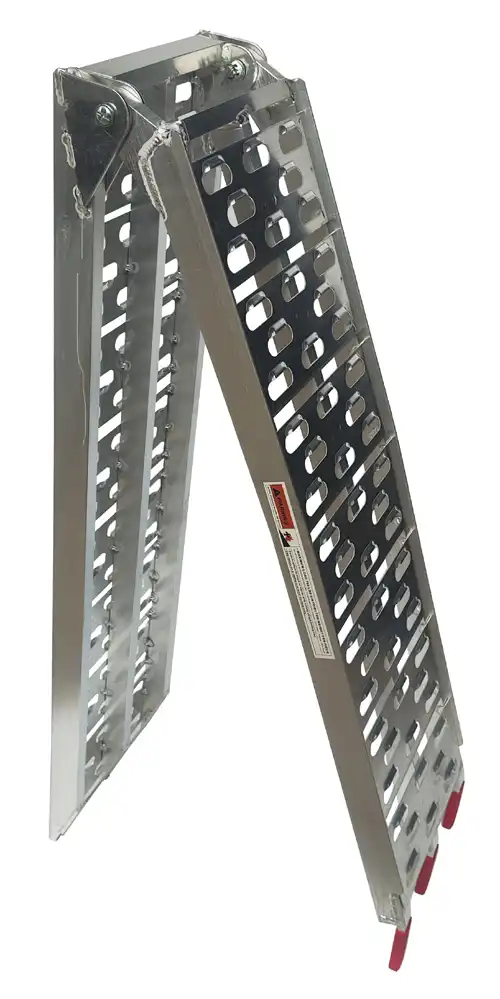The Evolution of Motorcycle Loading Solutions
Historical Methods of Motorcycle Loading
In the early days of motorcycle transportation, loading bikes onto vehicles was a precarious task. Riders often resorted to makeshift ramps constructed from wooden planks or relied on sheer manpower to hoist motorcycles onto truck beds. These methods were not only labor-intensive but also posed significant risks to both the vehicles and the individuals involved. The need for a safer, more efficient solution became increasingly apparent as motorcycle ownership and shipping requirements grew.
Emergence of Specialized Moto Ramps
The advent of purpose-built motorcycle ramps marked a significant milestone in the industry. Early designs featured simple metal constructions, offering improved stability over their wooden predecessors. As manufacturing techniques advanced, so did the sophistication of moto ramps. Manufacturers began incorporating features like foldable designs for easy storage, textured surfaces for enhanced traction, and adjustable widths to accommodate various motorcycle models.
Modern Innovations in Motorcycle Loading Ramps
Today's motorcycle loading ramps are marvels of engineering, boasting cutting-edge materials and design elements. Lightweight yet durable aluminum alloys have become the standard, offering an optimal balance between strength and portability. Some ramps now feature hydraulic assist mechanisms, making it possible for a single person to effortlessly load even the heaviest motorcycles. Additionally, smart ramps equipped with sensors and digital displays are emerging, providing real-time feedback on weight distribution and ramp angle to ensure optimal safety during the loading process.
Choosing the Right Moto Ramp for Your Shipping Needs
Assessing Load Capacity and Motorcycle Weight
Selecting the appropriate moto ramp begins with a thorough assessment of your motorcycle's weight and the ramp's load capacity. It's crucial to choose a ramp that can safely support not only the weight of your bike but also account for dynamic loads during the loading process. High-quality motorcycle ramps typically feature reinforced structures and are rated for specific weight limits. Always opt for a ramp with a capacity that exceeds your motorcycle's weight by at least 20% to ensure a margin of safety.
Considering Ramp Length and Incline Angle
The length of your motorcycle loading ramp directly impacts the incline angle, which in turn affects the ease and safety of loading. Longer ramps provide a gentler slope, reducing the risk of bottoming out and making it easier to push or ride the motorcycle up the incline. As a general rule, aim for a ramp length that creates an angle of 15 degrees or less with the loading surface. This can be calculated based on the height difference between the ground and the truck bed or trailer floor.
Material and Portability Factors
The material composition of your moto ramp influences both its durability and portability. Aluminum ramps are popular for their lightweight nature and resistance to corrosion, making them ideal for frequent use and easy transport. Steel ramps, while heavier, offer superior strength and may be preferable for larger motorcycles or commercial applications. Consider foldable or telescoping designs if storage space is limited or if you frequently need to transport the ramp itself. Some advanced models even feature modular construction, allowing you to adjust the width or length to accommodate different motorcycle types.
Maximizing Safety and Efficiency in Motorcycle Shipping
Proper Ramp Setup and Securement Techniques
Ensuring the stability of your motorcycle ramp is paramount to safe loading operations. Begin by inspecting the ramp for any signs of damage or wear before each use. When setting up, verify that the ramp is securely attached to the loading surface, using safety straps or locking mechanisms provided by the manufacturer. Position the ramp on a level surface and align it squarely with the vehicle or container. Some advanced ramps feature adjustable feet or leveling systems to compensate for uneven terrain, further enhancing stability during the loading process.
Optimizing Loading Procedures for Different Motorcycle Types
Different motorcycle styles require tailored approaches to loading. For sport bikes with low ground clearance, consider using a longer ramp or arched designs to prevent scraping. Heavier touring motorcycles may benefit from wider ramps that provide additional stability. When loading, maintain a steady, controlled pace and avoid sudden accelerations or braking. For manual loading, enlist the help of a spotter to guide the process and provide additional support if needed. Some riders prefer to use a winch system in conjunction with the moto ramp for added control, especially with larger or heavier motorcycles.
Leveraging Technology for Enhanced Shipping Efficiency
Advancements in technology are revolutionizing motorcycle shipping practices. GPS-enabled tracking systems allow shippers and customers to monitor the location and condition of motorcycles in transit. Smart ramps equipped with weight sensors and digital displays provide real-time feedback on load distribution, helping to prevent imbalances that could lead to accidents. Some shipping companies are even exploring the use of augmented reality (AR) applications to assist in optimal ramp placement and loading procedures, particularly for complex or oversized motorcycle shipments.
Conclusion
Moto ramps have revolutionized the bike shipping industry, advertising secure, effective, and user-friendly arrangements for stacking and emptying bicycles. By understanding the advancement of these fundamental devices, carefully selecting the right incline for your needs, and actualizing best hones in their utilize, you can altogether improve the security and productivity of your cruiser shipping operations. As innovation proceeds to development, we can anticipate indeed more inventive highlights in motorcycle loading ramps, advance streamlining the shipping prepare and guaranteeing the security of profitable cruisers amid transport.
Contact Us
Ready to elevate your motorcycle shipping experience? For more information on our cutting-edge moto ramp solutions and expert advice on efficient motorcycle transport, contact us at info@runva.com.cn. Let's work together to ensure your prized motorcycles reach their destination safely and securely.

_1737625693698.webp)


